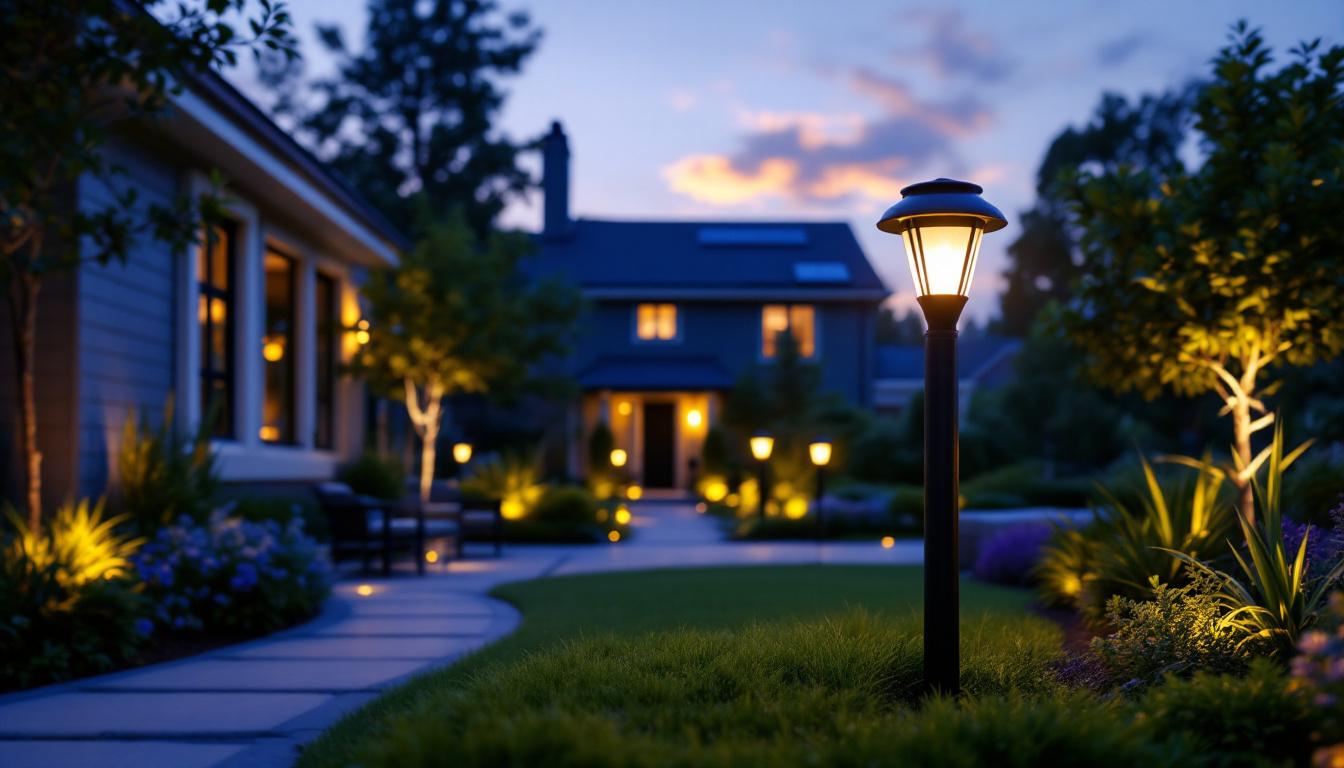
As outdoor security becomes increasingly important for both residential and commercial properties, the demand for effective lighting solutions has surged. Among these solutions, outdoor security lights equipped with motion sensors are gaining popularity. For lighting contractors, understanding the science behind these systems is crucial for providing clients with the best options available. This article delves into the technology, benefits, and installation considerations of motion sensor lights, offering valuable insights for professionals in the field.
Motion sensors are devices that detect movement in a specific area and trigger a response, such as turning on a light. There are several types of motion sensors used in outdoor security lighting, each with its unique mechanism and advantages. The most common types include passive infrared (PIR), microwave, and dual technology sensors.
PIR sensors are the most widely used in outdoor security lighting. They work by detecting changes in infrared radiation emitted by objects in their field of view. When a warm body, such as a person or animal, moves within the sensor’s range, the device activates the light. This type of sensor is energy-efficient and cost-effective, making it a popular choice for many applications. Additionally, PIR sensors are generally easy to install and maintain, making them ideal for residential and commercial properties alike.
Microwave sensors, on the other hand, emit microwave signals and measure the reflection of these signals to detect movement. They can cover a larger area than PIR sensors and are not affected by temperature changes. However, they may be more prone to false alarms due to their sensitivity to movement, including that of small animals or even blowing leaves. This characteristic can be mitigated by strategically placing the sensors and adjusting their sensitivity settings, thus allowing for more reliable operation in various outdoor environments.
The operation of motion sensors involves several key components: the sensor itself, a control unit, and the light fixture. When a motion sensor detects movement, it sends a signal to the control unit, which then activates the light fixture. The duration for which the light stays on can usually be adjusted, allowing contractors to customize the settings based on the specific needs of the installation site. This flexibility is particularly useful in areas with varying foot traffic, ensuring that lights are only activated when necessary.
Moreover, many modern motion sensors come with additional features such as adjustable sensitivity settings, timers, and even smart technology integration. These enhancements allow users to tailor the performance of their lighting systems, ensuring optimal functionality and energy efficiency. For instance, some advanced systems can be connected to home automation networks, enabling users to receive alerts on their smartphones when motion is detected, thus enhancing security and providing real-time updates on their property.
Outdoor security lights with motion sensors offer numerous advantages, making them an attractive option for both contractors and clients. One of the primary benefits is enhanced security. By illuminating areas only when movement is detected, these lights can deter potential intruders and provide peace of mind for property owners. The sudden activation of bright lights can startle trespassers, often causing them to flee before they can commit any unlawful acts.
Another significant advantage is energy efficiency. Traditional outdoor lighting systems often remain on throughout the night, leading to increased energy consumption and higher utility bills. In contrast, motion sensor lights only activate when needed, significantly reducing energy usage and costs. This not only benefits the environment by lowering carbon footprints but also contributes to long-term savings for homeowners and businesses. Furthermore, the convenience of motion sensor lights cannot be overstated. They provide automatic illumination when approaching a property, improving safety for residents and visitors alike. This feature is particularly beneficial in dark or poorly lit areas, where visibility is crucial for preventing accidents. Additionally, many motion sensor lights are designed to withstand various weather conditions, ensuring reliable performance throughout the seasons, which adds to their overall value and appeal in outdoor settings.
Before installing outdoor security lights with motion sensors, a thorough site assessment is essential. Contractors should evaluate the specific areas that require lighting, considering factors such as potential blind spots, the layout of the property, and the typical movement patterns of individuals in the vicinity. This assessment will help determine the optimal placement and type of motion sensors to use.
Additionally, it is important to consider environmental factors that may affect sensor performance. For instance, areas with heavy foliage or frequent wildlife activity may require adjustments in sensor sensitivity to minimize false alarms. Contractors should also take into account seasonal changes that could impact visibility and sensor effectiveness, such as snow accumulation in winter or dense foliage in summer. By understanding these dynamics, contractors can create a more reliable lighting plan that adapts to the changing environment throughout the year.
Selecting the appropriate motion sensor lights is crucial for ensuring optimal performance. Contractors should consider factors such as the sensor’s detection range, coverage area, and features like adjustable sensitivity and timers. It is also important to choose lights with adequate brightness and color temperature to meet the specific needs of the installation site.
Moreover, understanding the power source for the lights is vital. While many motion sensor lights are hardwired, there are also solar-powered options available. Solar lights can be an excellent choice for remote areas with limited access to electricity, but they may require more maintenance and consideration of sunlight exposure. In addition, contractors should be aware of the battery life and replacement options for solar-powered units, as well as the potential for energy-efficient LED bulbs that can significantly reduce electricity costs while providing ample illumination.
Proper installation is key to maximizing the effectiveness of motion sensor lights. Contractors should ensure that sensors are mounted at the recommended height and angle for optimal detection. Typically, this height ranges from 6 to 10 feet, depending on the sensor type and the area being illuminated.
Additionally, positioning the sensors to minimize obstructions is essential. This may involve trimming nearby vegetation or avoiding placement near objects that could cause interference, such as moving branches or fences. Proper wiring and connections should also be prioritized to ensure reliability and safety. Furthermore, testing the system after installation is crucial; contractors should walk through the coverage area to confirm that the sensors activate as intended and adjust settings as necessary. This final check not only ensures functionality but also provides peace of mind to clients, knowing their security system is operating effectively.
One of the most common challenges associated with motion sensor lights is the occurrence of false alarms. These can be triggered by various factors, including pets, wildlife, or even environmental conditions such as wind. To mitigate this issue, contractors can recommend sensors with adjustable sensitivity settings, allowing users to customize the detection range based on their specific environment.
Additionally, the use of dual technology sensors can significantly reduce false alarms. By combining PIR and microwave technologies, these sensors require confirmation from both systems before activating the light, leading to more accurate detection. This dual approach not only minimizes unnecessary activations but also enhances the overall reliability of the lighting system, making it a worthwhile investment for homeowners concerned about security and energy efficiency.
Moreover, educating users on the placement of these sensors can further help in reducing false alarms. For instance, positioning sensors away from high-traffic areas where pets or passing cars might trigger them can lead to a more effective system. By strategically placing the sensors, homeowners can ensure that the lights only activate when truly necessary, thus saving energy and reducing wear on the system.
Regular maintenance is crucial for ensuring the longevity and effectiveness of motion sensor lights. Contractors should advise clients on the importance of cleaning the sensors and light fixtures periodically to prevent dirt and debris buildup that can hinder performance. Furthermore, checking the batteries or power sources regularly will help avoid unexpected outages.
Educating clients about the features and settings of their motion sensor lights is also essential. Providing guidance on how to adjust sensitivity and timers can empower users to optimize their lighting systems for their specific needs. Additionally, contractors can recommend seasonal checks, particularly before winter or summer, when weather conditions might impact sensor performance. By encouraging clients to perform these routine checks, they can maintain optimal functionality and ensure their motion sensor lights are always ready to provide safety and security.
As technology continues to advance, the integration of motion sensor lights with smart home systems is becoming increasingly popular. This allows users to control their outdoor lighting remotely, receive alerts on their smartphones, and even integrate the lights with other security measures, such as cameras and alarms.
Contractors should stay informed about the latest smart technology trends and products available in the market. This knowledge will enable them to offer clients modern solutions that enhance security and convenience while keeping up with evolving consumer demands. Furthermore, the ability to program motion sensor lights to work in conjunction with other smart devices, such as smart locks or doorbell cameras, can create a comprehensive security ecosystem. Homeowners can enjoy peace of mind knowing that their property is well-lit and monitored, all while having the flexibility to adjust settings from anywhere, whether they are at home or away.
Moreover, as smart home technology evolves, the potential for future upgrades and integrations will continue to grow. For example, some systems now allow for voice control through platforms like Amazon Alexa or Google Assistant, making it even easier for users to manage their lighting without needing to physically interact with the devices. This level of convenience not only enhances the user experience but also encourages the adoption of smart technology in everyday life.
Outdoor security lights with motion sensors represent a significant advancement in lighting technology, offering enhanced security, energy efficiency, and convenience. For lighting contractors, understanding the science behind these systems is essential for providing clients with effective solutions tailored to their needs.
By familiarizing themselves with the various types of motion sensors, installation best practices, and potential challenges, contractors can ensure successful installations that meet the highest standards of performance. As the demand for outdoor security lighting continues to grow, staying informed about industry trends and technological advancements will be key to remaining competitive in this evolving market.
Ultimately, the integration of motion sensor technology into outdoor lighting systems not only enhances security but also contributes to a safer and more energy-efficient environment for all. By embracing these advancements, lighting contractors can play a vital role in shaping the future of outdoor security solutions.
Ready to elevate your lighting projects with the latest in motion sensor technology? Look no further than LumenWholesale for all your outdoor security lighting needs. Our extensive selection of spec-grade lighting products ensures you have access to the best quality without the high markups. With LumenWholesale, you can take advantage of wholesale prices, free shipping, and the convenience of bulk buying. Don’t compromise on quality or value; choose LumenWholesale for reliable, high-performance lighting solutions that meet the highest industry standards. Wholesale Lighting at the Best Value is just a click away. Upgrade your lighting inventory today and provide your clients with the security and efficiency they deserve.

Discover why purchasing light bulbs and LED tubes in bulk from local distributors might not be the best choice.

Discover how LED tubes are revolutionizing the lighting industry, offering energy efficiency, cost savings, and enhanced versatility for contractors.

Discover how solar black lights are revolutionizing the lighting industry, offering eco-friendly solutions and innovative design possibilities for contractors.

Discover the often-overlooked aspects of bollard lights that every lighting contractor should know.